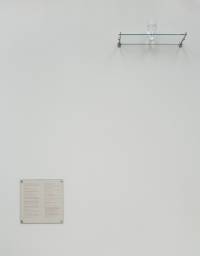In my previous posting, I touched on how contemporary art these days, seek to set you thinking. Basketballs half afloat in tanks, diamond-laden human skull, and a glass of water on a shelf, they maybe ordinary looking. But hey, their million dollar price tags are enough to make you stare in disbelief! Buyers say that these works are thought-provoking, plus a fantastic concept, therefore justifying the hefty price-tag.

Three Ball 50/50 Tank by Jeff Koons

An Oak Tree by Craig-Martin (you're right! its a glass of water on a shelf)
New York Times has also highlighted that works like these lack the skillful craftsmanship but are revered for the hidden story, concept or whatever you think it represents.

For The Love Of God by Damien Hirsts
Ok, so I did an online search for the idea behind these works. Let me quote a description on the skull above.
For the Love of God is a life-size cast of a human skull in platinum, covered entirely by 8,601 VVS to flawless pavé-set diamonds, weighing a total of 1,106.18 carats. On one level, the work is a traditional ‘Memento Mori’, an object that addresses the transience of human existence. ‘The skull is out of this world, celestial almost’ writes the distinguished art historian Rudi Fuchs. ‘It proclaims victory over decay. At the same time’, Fuchs continues, ‘it represents death as something infinitely more relentless. Compared to the tearful sadness of a vanitas scene, the diamond skull is glory itself.
Hmmm, perhaps I’m too superficial, but am I the only one who fails to understand the million dollar story?
To me, an artist should possess both the skill and brains to create an aesthetic object that relates to audiences in a meaningful manner. A work is not profound if it says a lot but can be created without years of painstaking practice. A case in point would be Rabbit (1986) by Jeff Koons. Contractors manufactured the art and Koons originated the concept. Neither will it be truly outstanding if it’s only a pretty piece of work (honestly, there are too many pretty looking arts in the market already). So substance is as important as mastery.
That is why I’m in love with a 9-metre long imaginary landscape by Wu Bin (1537 – 1620) showcased in Asian Civilisation Museum, Singapore. That is about 2/3 the length of a public bus, not an easy feat to complete. The fine and delicate work will leave you in awe. And it relates to almost everybody who sees it. (sorry for being unable to upload a picture of art). The beauty is timeless. I can look at it 50 years later and still be impressed at the artist’s level of technique. I’m not quite sure if the buyer of Three Balls 50/50 Tank will feel the same? In all honesty, I hope he will, considering how much he paid for it.





